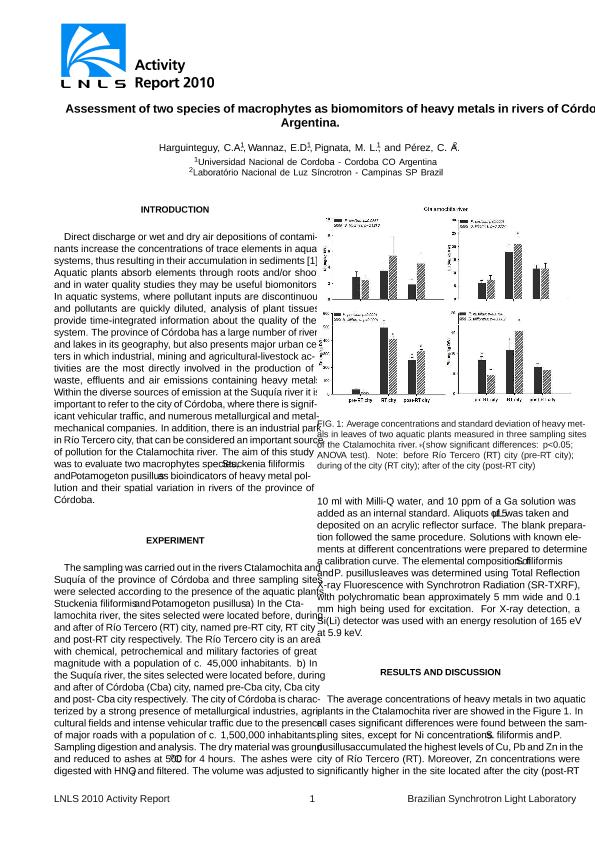Mostrar el registro sencillo del ítem
dc.contributor.author
Harguinteguy, Carlos Alfredo

dc.contributor.author
Wannaz, Eduardo Daniel

dc.contributor.author
Pignata, María Luisa
dc.contributor.author
Pérez, Carlos A.
dc.date.available
2017-03-02T18:47:31Z
dc.date.issued
2011-12
dc.identifier.citation
Harguinteguy, Carlos Alfredo; Wannaz, Eduardo Daniel; Pignata, María Luisa; Pérez, Carlos A.; Assessment of two species of macrophytes as biomomitors of heavy metals in rivers of Córdoba, Argentina; Brazilian Ministry of Science and Technology / Brazilian Association for Synchrotron Light Technology; LNLS 2010 Activity Report. Brazilian Synchrotron Light Laboratory; 12-2011; 1-2
dc.identifier.issn
1518-0204
dc.identifier.uri
http://hdl.handle.net/11336/13483
dc.description.abstract
Direct discharge or wet and dry air depositions of contaminants increase the concentrations of trace elements in aquatic systems, thus resulting in their accumulation in sediments. Aquatic plants absorb elements through roots and/or shoots and in water quality studies they may be useful biomonitors. The aim of this study was to evaluate two macrophytes species, Stuckenia filiformis and Potamogeton pusillus as bioindicators of heavy metal pollution and their spatial variation in rivers of the province of Córdoba. The sampling was carried out in the rivers Ctalamochita and Suquía of the province of Córdoba. The elemental composition of S. filiformis and P. pusillus leaves was determined using Total Reflection X-ray Fluorescence with Synchrotron Radiation (SR-TXRF). In all cases significant differences were found between the sampling sites, except for Ni concentrations. S. filiformis and P. pusillus accumulated the highest levels of Cu, Pb and Zn in the city of Río Tercero. Moreover, Zn concentrations were significantly higher in the site located after the city. As for the Suquía river, the highest values of Cu, Pb and Zn were found after the city of Córdoba. The species S. filiformis and P. pusillus behaved as effective biomonitors of aquatic quality.
dc.format
application/pdf
dc.language.iso
eng
dc.publisher
Brazilian Ministry of Science and Technology / Brazilian Association for Synchrotron Light Technology
dc.rights
info:eu-repo/semantics/openAccess
dc.rights.uri
https://creativecommons.org/licenses/by-nc-sa/2.5/ar/
dc.subject
Biomomitors
dc.subject
Heavy Metals
dc.subject
Surface Water
dc.subject.classification
Ciencias Medioambientales

dc.subject.classification
Ciencias de la Tierra y relacionadas con el Medio Ambiente

dc.subject.classification
CIENCIAS NATURALES Y EXACTAS

dc.title
Assessment of two species of macrophytes as biomomitors of heavy metals in rivers of Córdoba, Argentina
dc.type
info:eu-repo/semantics/article
dc.type
info:ar-repo/semantics/artículo
dc.type
info:eu-repo/semantics/publishedVersion
dc.date.updated
2017-02-14T14:35:01Z
dc.journal.pagination
1-2
dc.journal.pais
Brasil

dc.journal.ciudad
Campinas
dc.description.fil
Fil: Harguinteguy, Carlos Alfredo. Consejo Nacional de Investigaciones Científicas y Técnicas. Centro Científico Tecnológico Córdoba. Instituto Multidisciplinario de Biología Vegetal (p); Argentina
dc.description.fil
Fil: Wannaz, Eduardo Daniel. Consejo Nacional de Investigaciones Científicas y Técnicas. Centro Científico Tecnológico Córdoba. Instituto Multidisciplinario de Biología Vegetal (p); Argentina
dc.description.fil
Fil: Pignata, María Luisa. Consejo Nacional de Investigaciones Científicas y Técnicas. Centro Científico Tecnológico Córdoba. Instituto Multidisciplinario de Biología Vegetal (p); Argentina. Universidad Nacional de Córdoba; Argentina
dc.description.fil
Fil: Pérez, Carlos A.. Brazilian Synchrotron Light Laboratory; Brasil
dc.journal.title
LNLS 2010 Activity Report. Brazilian Synchrotron Light Laboratory
dc.relation.alternativeid
info:eu-repo/semantics/altIdentifier/url/http://www.lnls.br/ar2010/search.html
Archivos asociados
